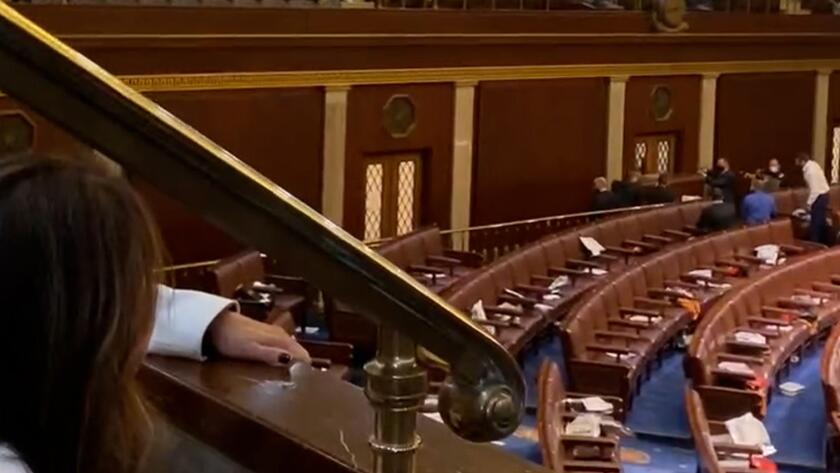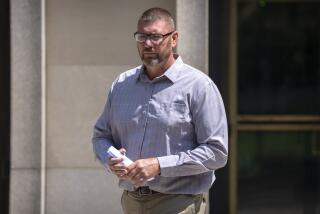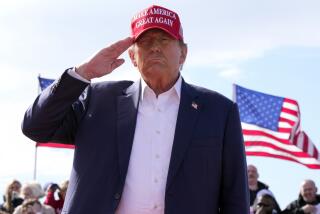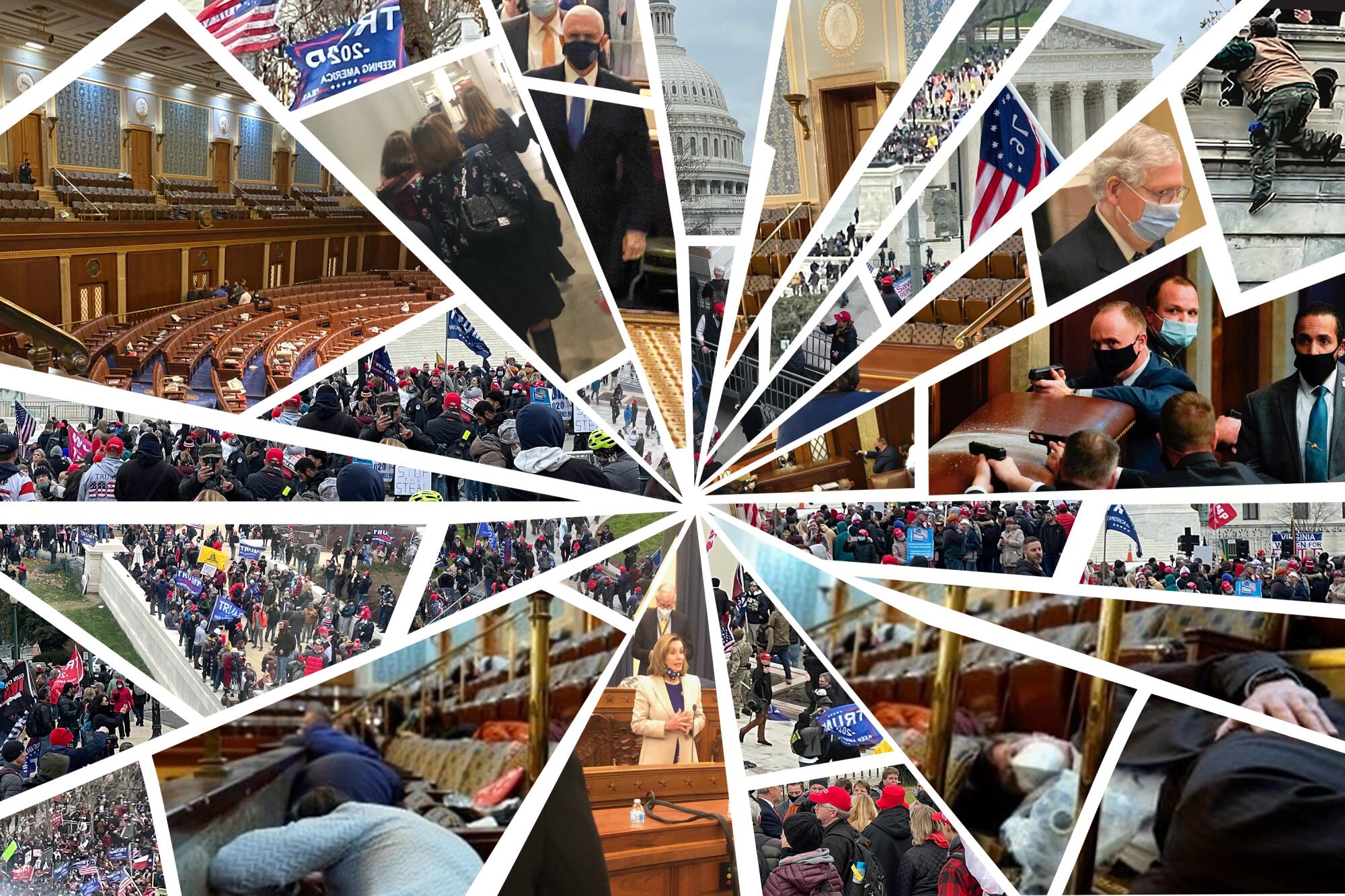
- Share via
WASHINGTON — Many Americans watched video footage of the crowd attacking the Capitol on Jan. 6, 2021, but few have a firsthand account of what happened inside. Three years ago, Times reporter Sarah D. Wire wrote about her experience, typing it out on a cellphone from the House safe room. She was one of three reporters to make it inside.
Now, with the aid of time and surveillance footage recently made available by the House, along with additional firsthand accounts from Rep. Norma Torres (D-Pomona), Sen. John Boozman (R-Ark.) and freelance congressional correspondent Matt Laslo, Wire provides a more expansive view of what it was like inside the Capitol that day.
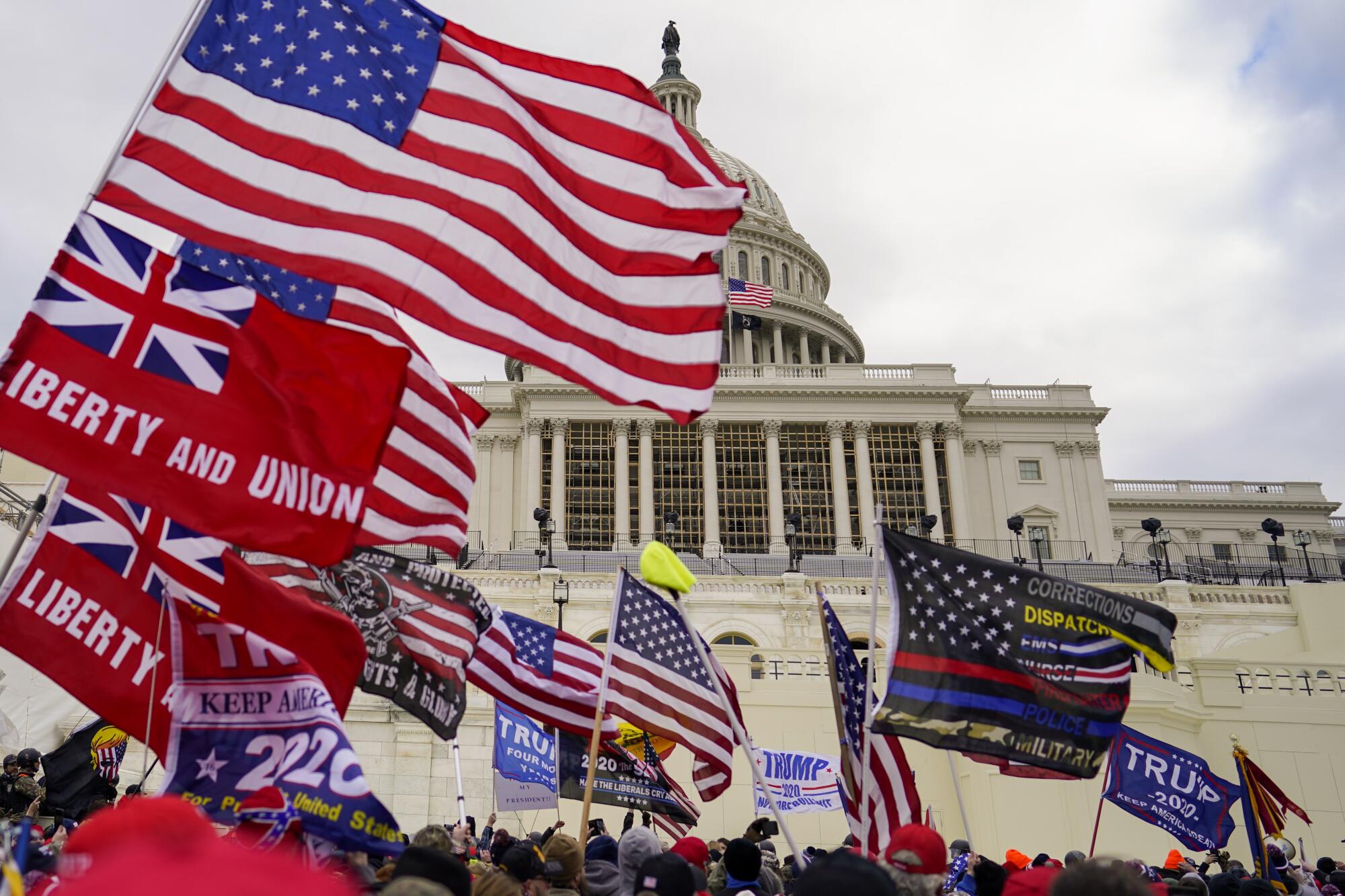
I knew there was going to be a massive protest in Washington on Jan. 6, 2021. Then-President Trump had been talking about it for weeks. I knew violence was likely. A mid-December MAGA event had become violent. Social media platforms were full of open calls for civil war and revolution, and dozens of news outlets had written about it.
But I worked inside the U.S. Capitol, the safest place on Earth, as I reminded my husband the night before — I was worried about the reporters who would be outside.
While I obliged my husband’s pleas to wear plain clothes and get into the building as swiftly as possible, I never thought twice about working that day.
There was nothing I loved more than being in the House or Senate chambers for important events, including a ceremonial moment like the counting of the electoral college votes. Many Americans never get to set foot in their Capitol, and I felt a responsibility to tell them what happens there.
I arrived about 11:15 a.m. COVID-19 restrictions had greatly reduced the number of people allowed on Capitol Hill. Rather than the thousands of staff members and tourists who typically fill the building, I passed just handfuls of people on their way to offices or the Capitol.
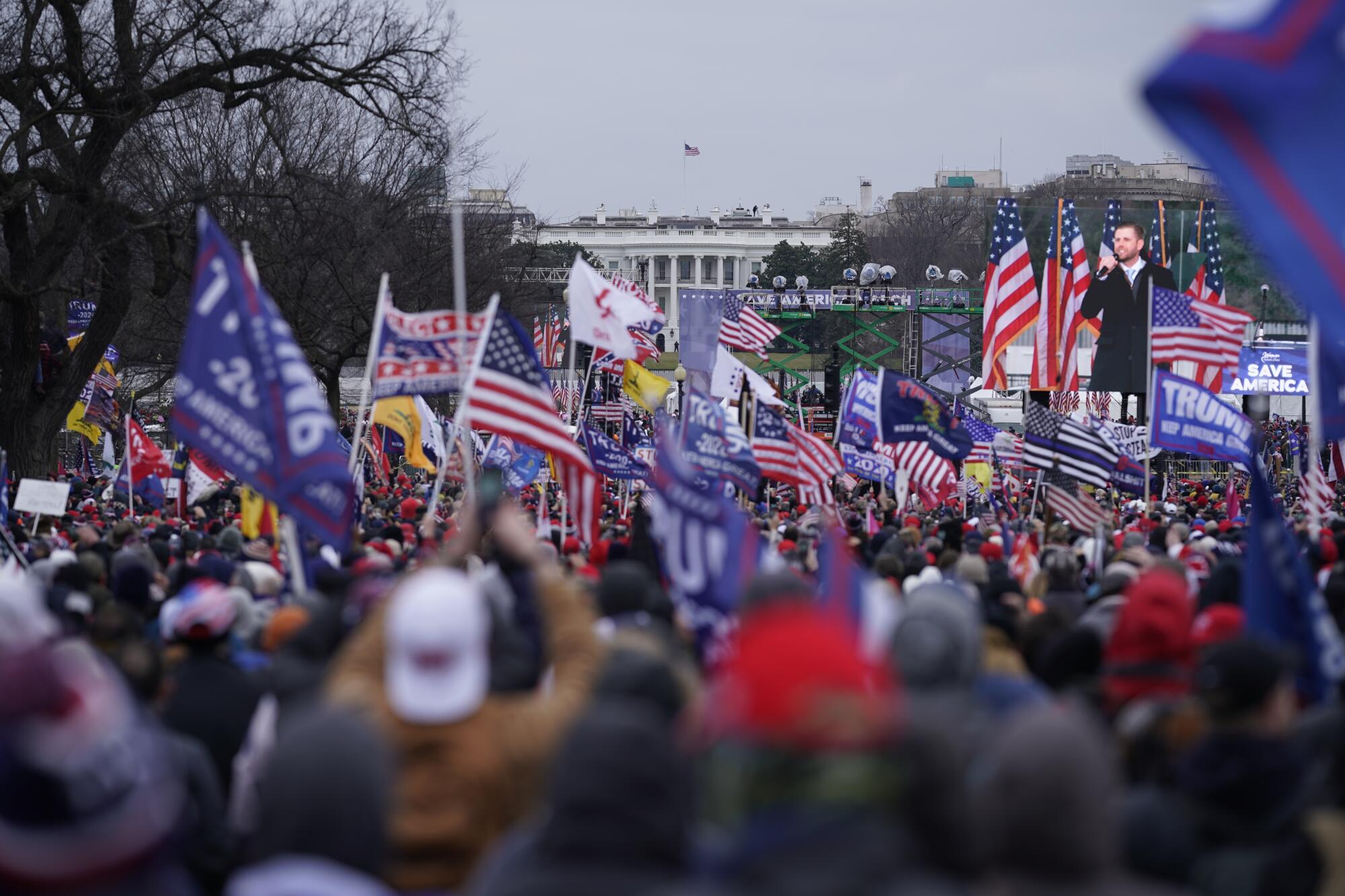
Rep. Norma Torres (D-Pomona), worried that protesters might cause traffic, had arrived early. She bought a Boston cream pie doughnut on her way in, a nod to the Día de Los Tres Reyes celebration she would normally have on Jan. 6 with her staff, who were working from home.
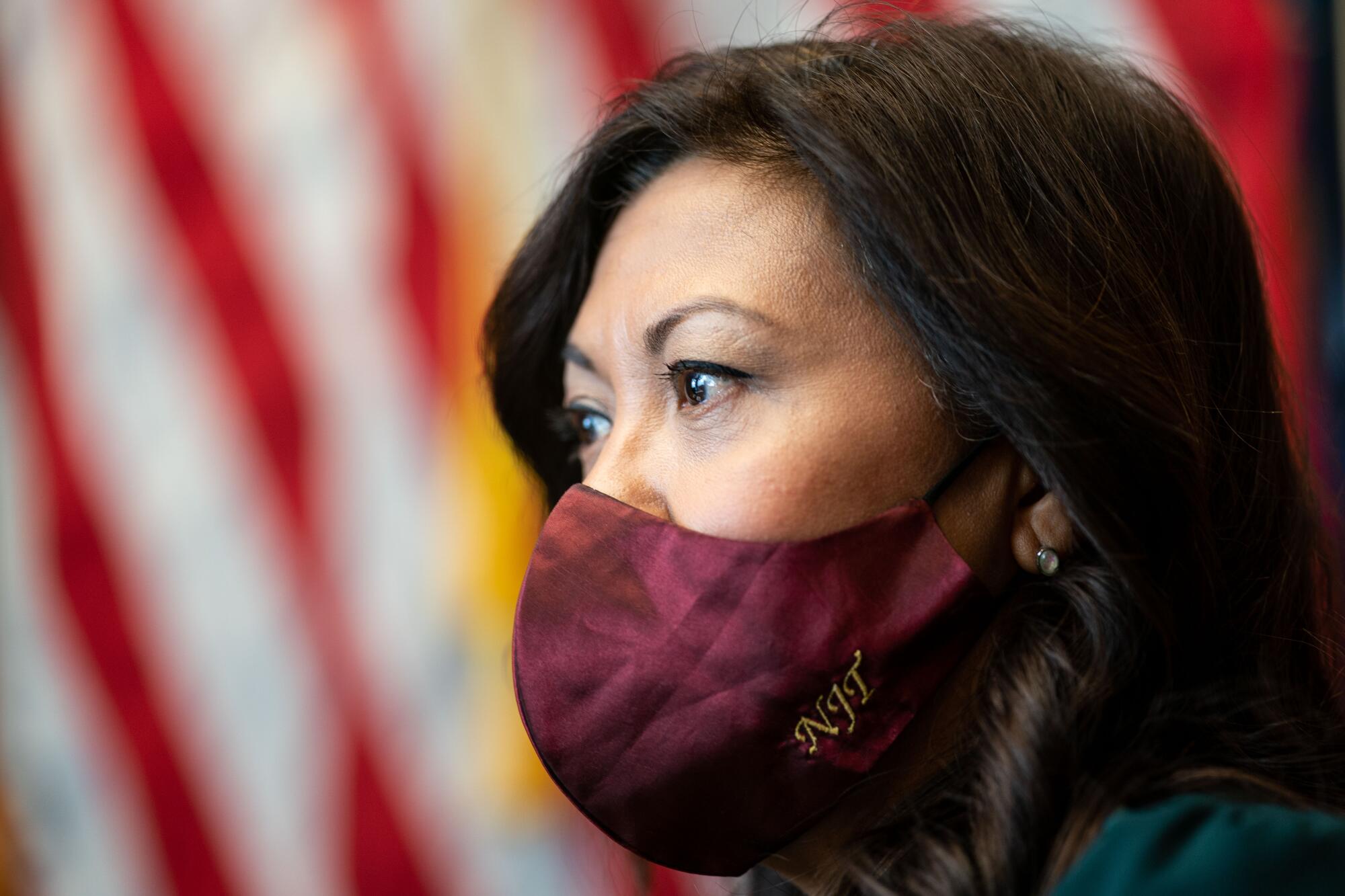
Since then, she’s been unable to eat Boston cream pie doughnuts.
“I have purchased at least half a dozen, and they stay and rot in my bag,” she said.
The joint session begins
I settled into my seat in the press gallery above the speaker’s dais about 12:45 p.m. and prepared to watch the joint session of Congress convene for the electoral vote count. I’ll always consider that front-row spot my seat.
Capitol Police lost control of the first barrier on the west side of the building at 12:53 p.m. as senators walked to the House chamber.
Rioters were streaming over fences and barricades by the time then-House Speaker Nancy Pelosi (D-San Francisco) gaveled in the joint session of Congress at 1:05 p.m.
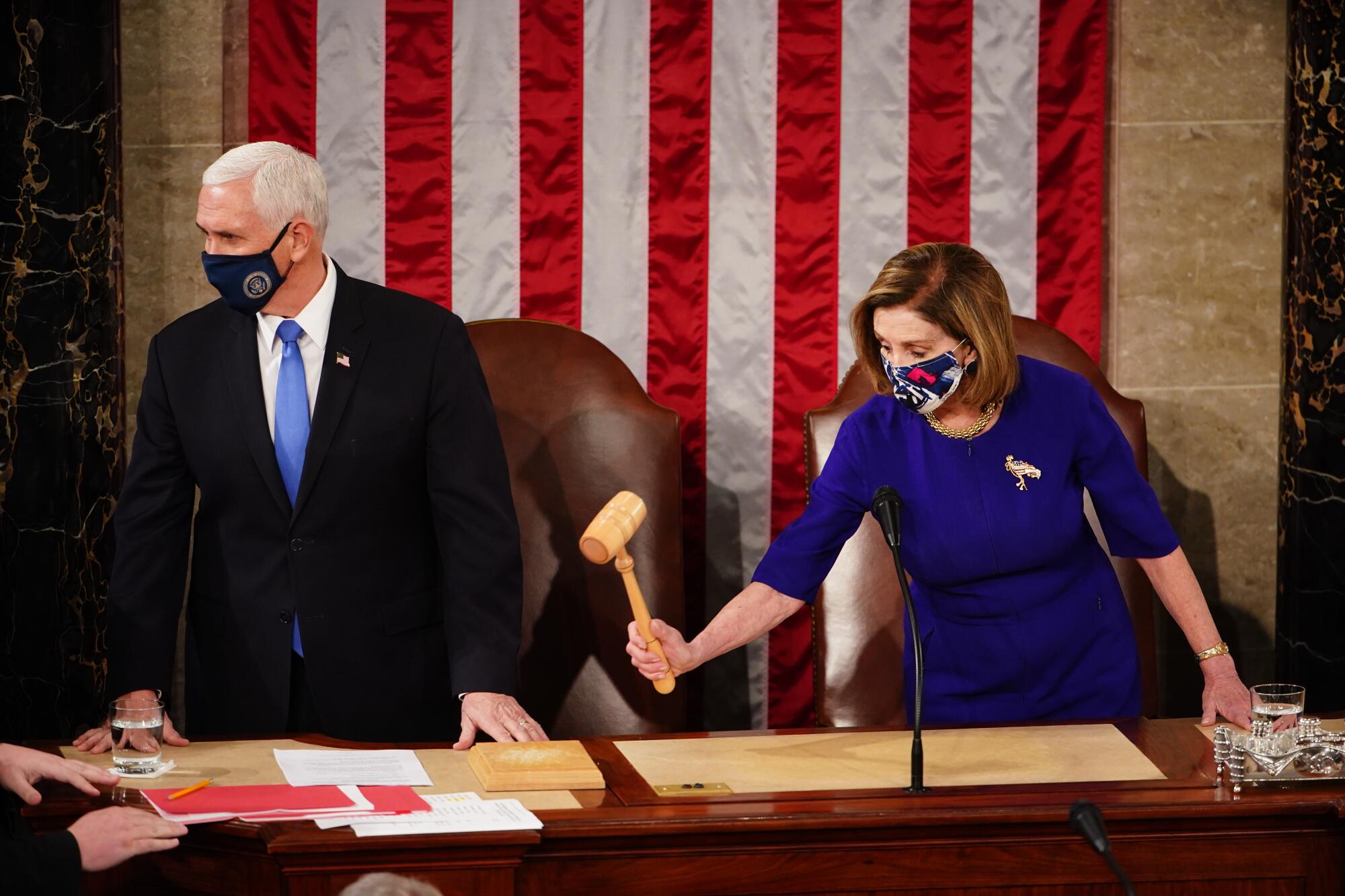
Because of COVID-19 precautions, only members chosen to present for their states were allowed on the House floor. Many watched from their offices. Torres joined the members sitting in the gallery above the chamber.
Senators and representatives counted the votes in alphabetical order of states. When they reached Arizona, Sen. Ted Cruz (R-Texas) and Rep. Paul Gosar (R-Ariz.) objected to recording the state’s11 electoral votes. The House and Senate retired to their respective chambers to debate the objections.
I stayed in the House. Just half a dozen lawmakers had spoken when I learned there might be trouble. My phone buzzed at 1:41 p.m. — I received a Capitol Police alert saying House office buildings had been locked down.
I was working at the Capitol when the Trump D.C. riots hit.
Sen. John Boozman (R-Ark.) said he had no inkling of what was happening as senators headed back to their chamber to debate. He’s used to the noise; protests are common on Capitol Hill.
Boozman joked with his old friend Mike Pence before the then-vice president ascended the dais that they needed to go golfing.
“He said, ‘Well, I’ve got plenty of time to do it now,’” Boozman recalled.
At 1:42 p.m., congressional correspondent Matt Laslo noticed Pence’s Secret Service detail inthe hallway outside the Senate chamber.
“You could feel their nervousness,” Laslo said.
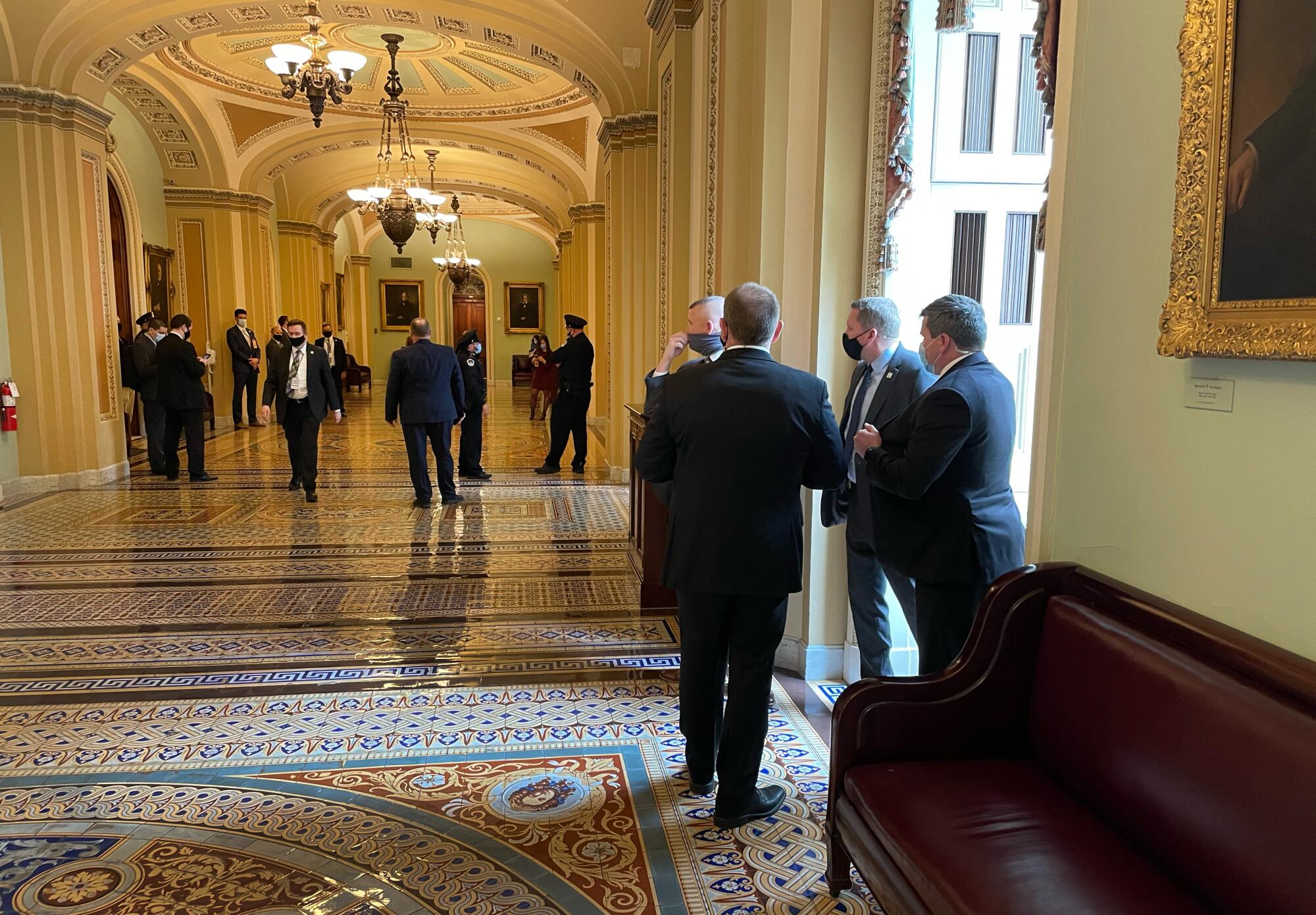
He watched through a second-floor window as the crowd surged up the steps under the inaugural platform to reach the West Terrace. The Capitol shook with the force of percussion grenades, and smoke rose above the crowd. At 2:11 p.m., Laslo recorded the rioters’ first breach of the Capitol, at the Senate-wing doors.
“You felt the roar of the crowd as they entered,” he said.
Meanwhile, inside the Senate chamber, Boozman realized something was wrong when he saw someone whisper in Pence’s ear.
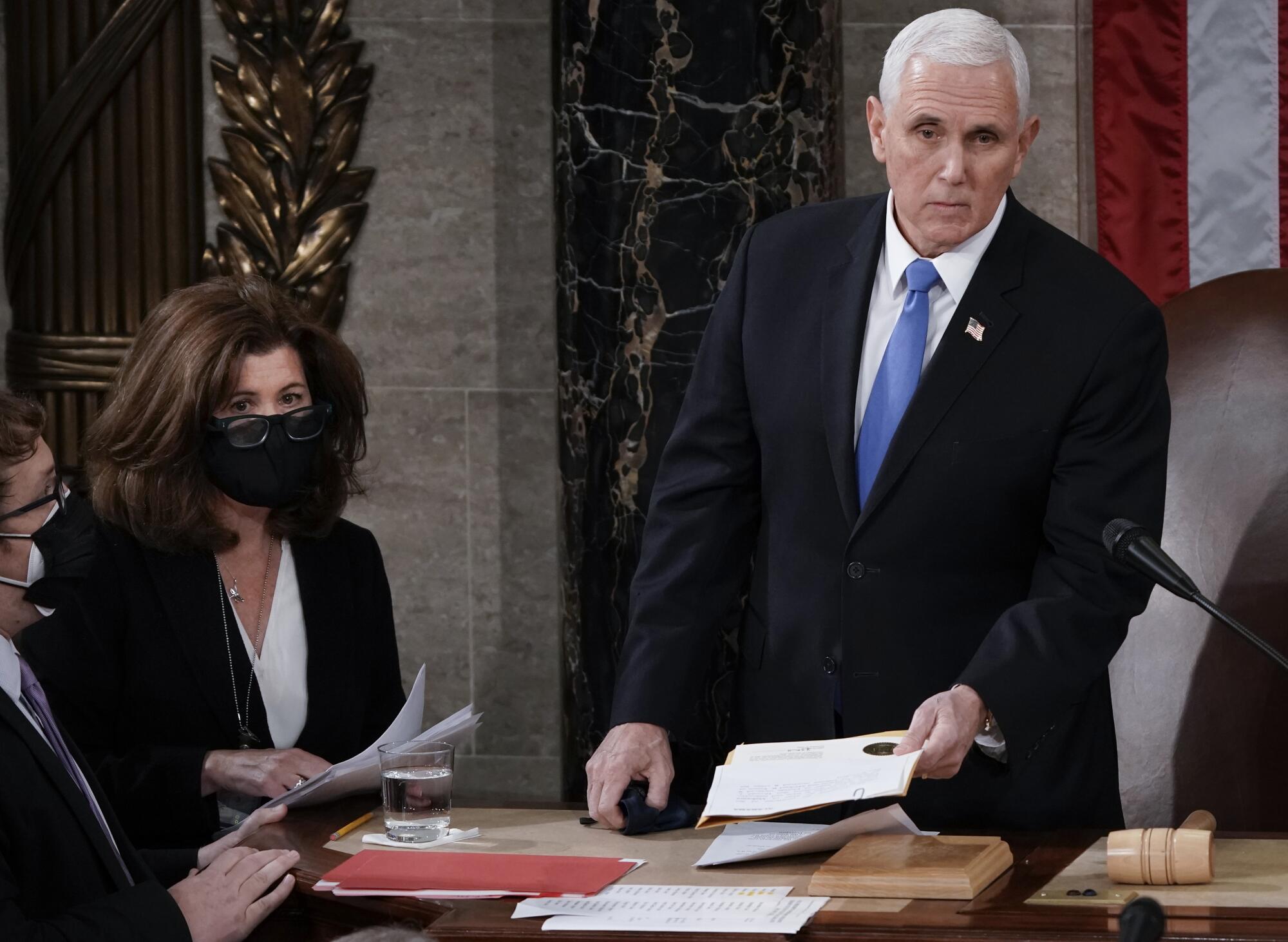
“We have lots of drills around here. And there’s a difference in having a drill and then looking at the sergeant of arms ... seeing a look of worry on their face,” he said. “You could just tell that they were very concerned.”
Officers scrambled to lock the chamber doors at 2:13 p.m.; Sen. Charles E. Grassley (R-Iowa), then third in line for the presidency, was pulled out of the chamber one minute later. Senate staff members scurried to gather their belongings and raced into the chamber. Capitol Police officers barricaded one of the senators-only stairways with office furniture.
Laslo saw Capitol Police Officer Eugene Goodman tell Sen. Mitt Romney (R-Utah), who was leaving the chamber, to turn around because he would be safer inside. Goodman ran downstairs and slowed rioters’ ascent to the second floor, buying time to lock the Senate chamber.
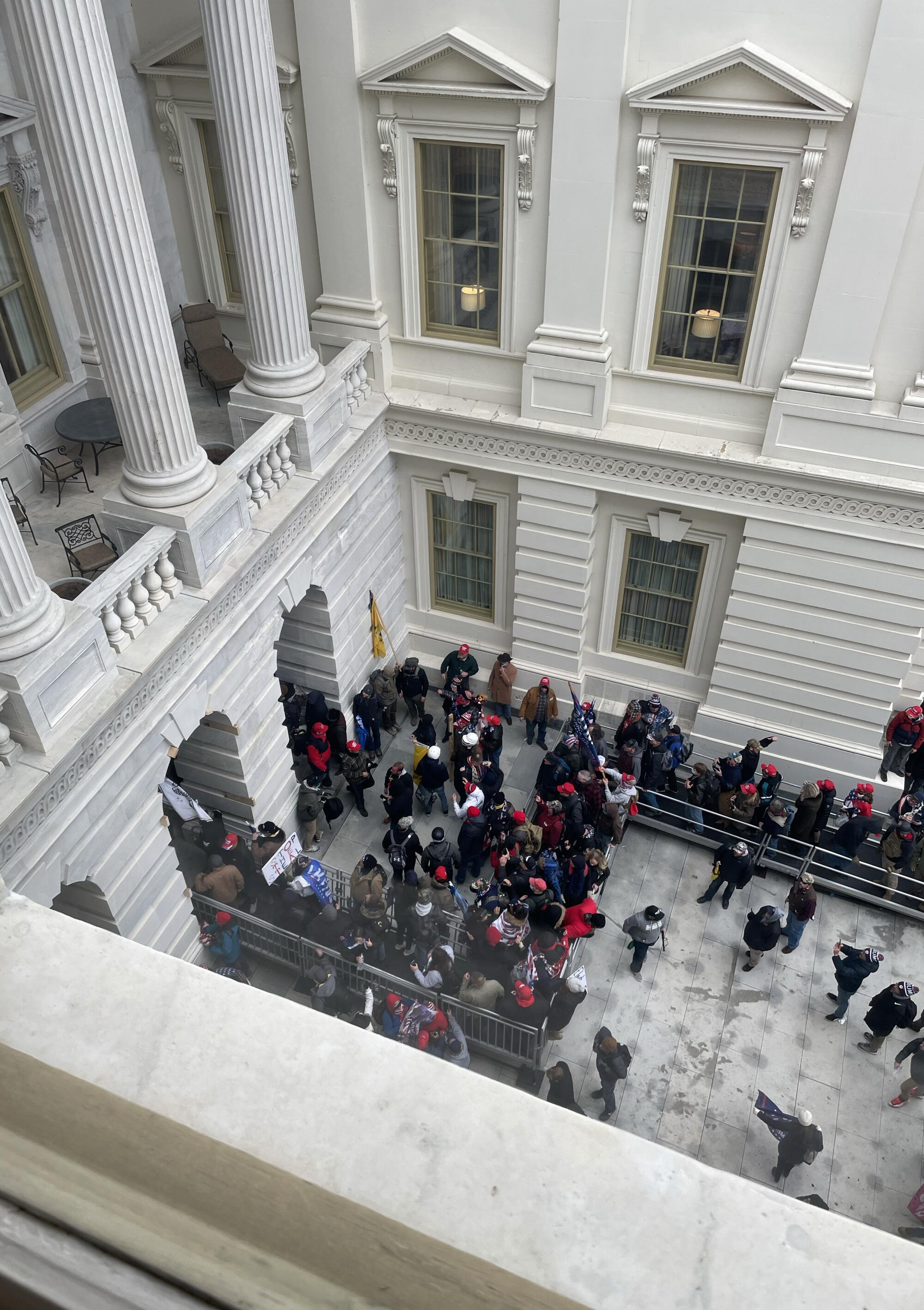
Laslo raced up the stairs to the third-floor windows to take photos of what was happening outside. The hallway was empty; the officers who’d been stationed outside the Senate public galleries had been called elsewhere.
“There was this weird calm before the storm” on the third floor, he told me. “You could tell stuff was happening down there, but up here was just dead quiet.”
The Capitol locks down
At 2:13 p.m., I walked into the House press offices in time to hear the emergency radio crackle to life.
“Due to an external security threat located on the West Front of the U.S. Capitol Building, no entry or exit is permitted at this time,” a panicked voice said. “You may move throughout the building, but stay away from exterior windows and doors. If you are outside, seek cover.”
I ran back to my seat in the House gallery to alert my editors. I looked over the railing into the chamber and noticed that Pelosi, second in line to the presidency, had been spirited away by her security detail.
Torres received a text at 2:18 p.m.: “Capitol: Internal security threat: move inside office/lock doors, seek cover and remain silent. USCP.”
Behind me, about a dozen reporters were ushered into the gallery from the press offices before police shut and locked the doors. Officers interrupted the proceedings to announce that tear gas had been deployed in the Capitol Rotunda. They told representatives to pull air filtration hoods from beneath their seats.
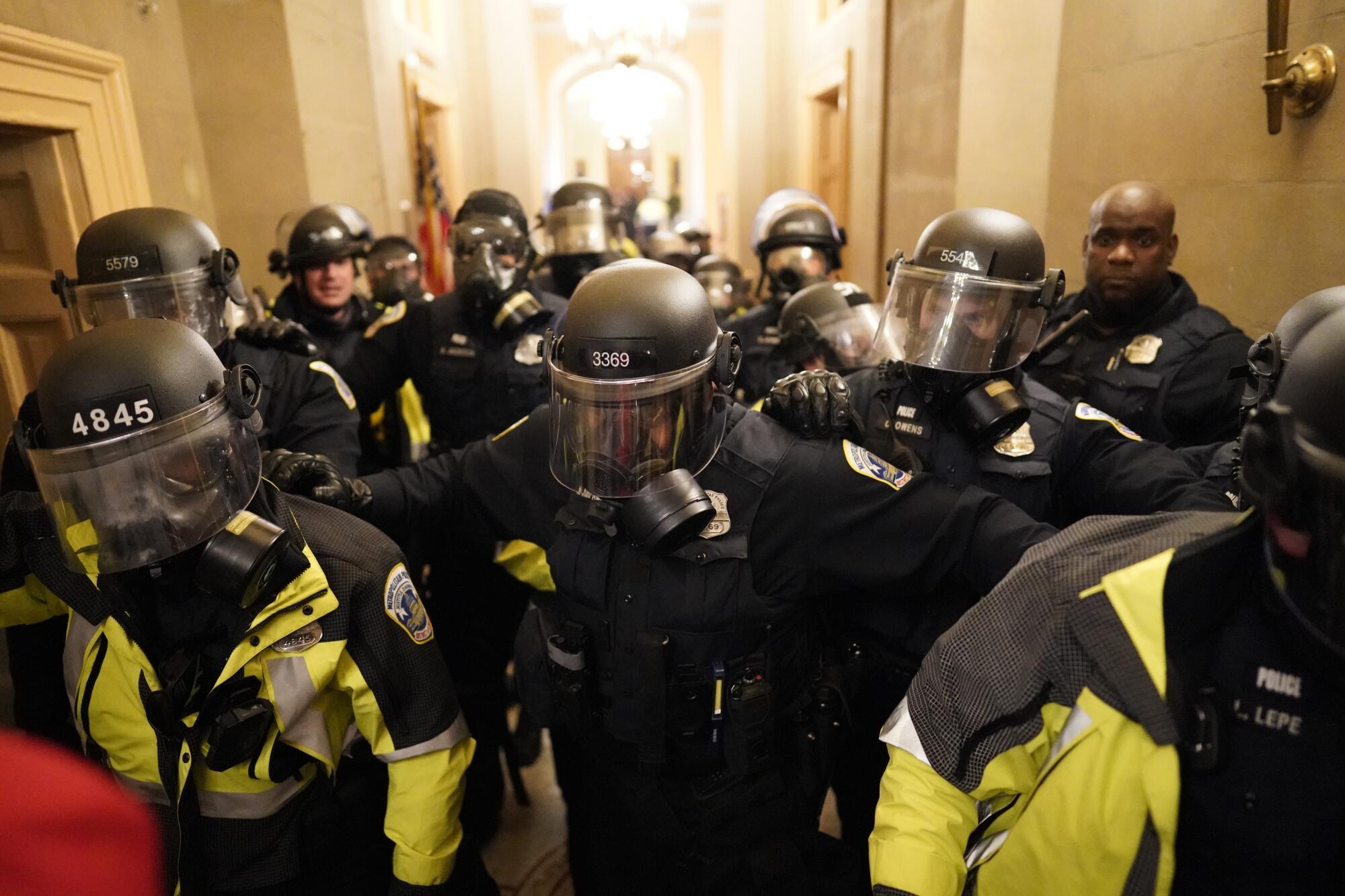
A staff member handed out more hoods in the gallery, and we passed them down the row until everybody had one.
Rep. Ruben Gallego (D-Ariz.), a former combat Marine, stood on a table and yelled instructions to other members on how to use the hoods.
Suddenly, the doors to the chamber closed one by one. It was about 2:20 p.m.
“When these wooden doors that are 8 foot tall slam, that echo is so disturbing,” Torres said.
Police began to escort lawmakers off the House floor through the Speaker’s Lobby. Representatives in the gallery were told to get on their hands and knees and crawl. Suddenly there was a frantic demand to get up and run for the center door.

Representatives were ordered to put on emergency air filtration hoods because tear gas had been deployed to clear the rioters. Once activated, the motors emitted a high-pitched whine for hours. (Rep. Norma Torres)
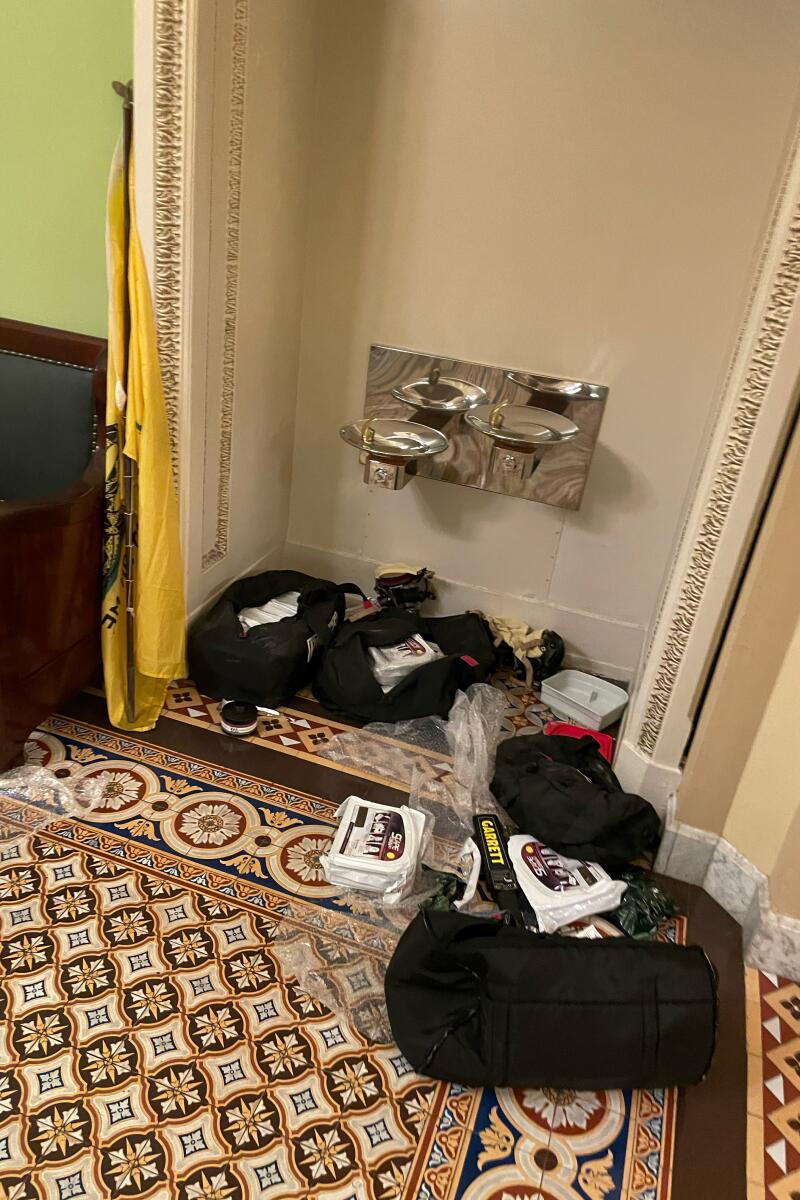
Emergency air filtration hoods and other Capitol Police gear were strewn about. Reporters encountered the mess as they were escorted from the building. (Matt Laslo)
Torres stayed behind to help representatives who couldn’t run. The doors to exit the gallery slammed shut before she and the members could reach them.
“I didn’t think we were going to ever leave,” she said. “We started to look for [makeshift] weapons. How are we going to defend ourselves? How are we going to fight back?”
A few lawmakers still on the floor assisted plainclothes officers in shoving a bookcase in front of the chamber’s main entry — the same one the president passes through for the State of the Union address.
Officers on the floor shouted at reporters to move from their seats across from the main doors and get out of a direct line of fire. We scrambled over railings and chairs.
“Crouch on the floor!” an officer shouted. “Get as low as you can!”
I slid to my belly behind a row of chairs in the box where the first lady sits during the State of the Union.
Outside the chamber, Capitol Police were quickly overwhelmed as they fought to prevent access to the building at multiple points on the east and west fronts of the Capitol, while others worked to secure representatives and senators.
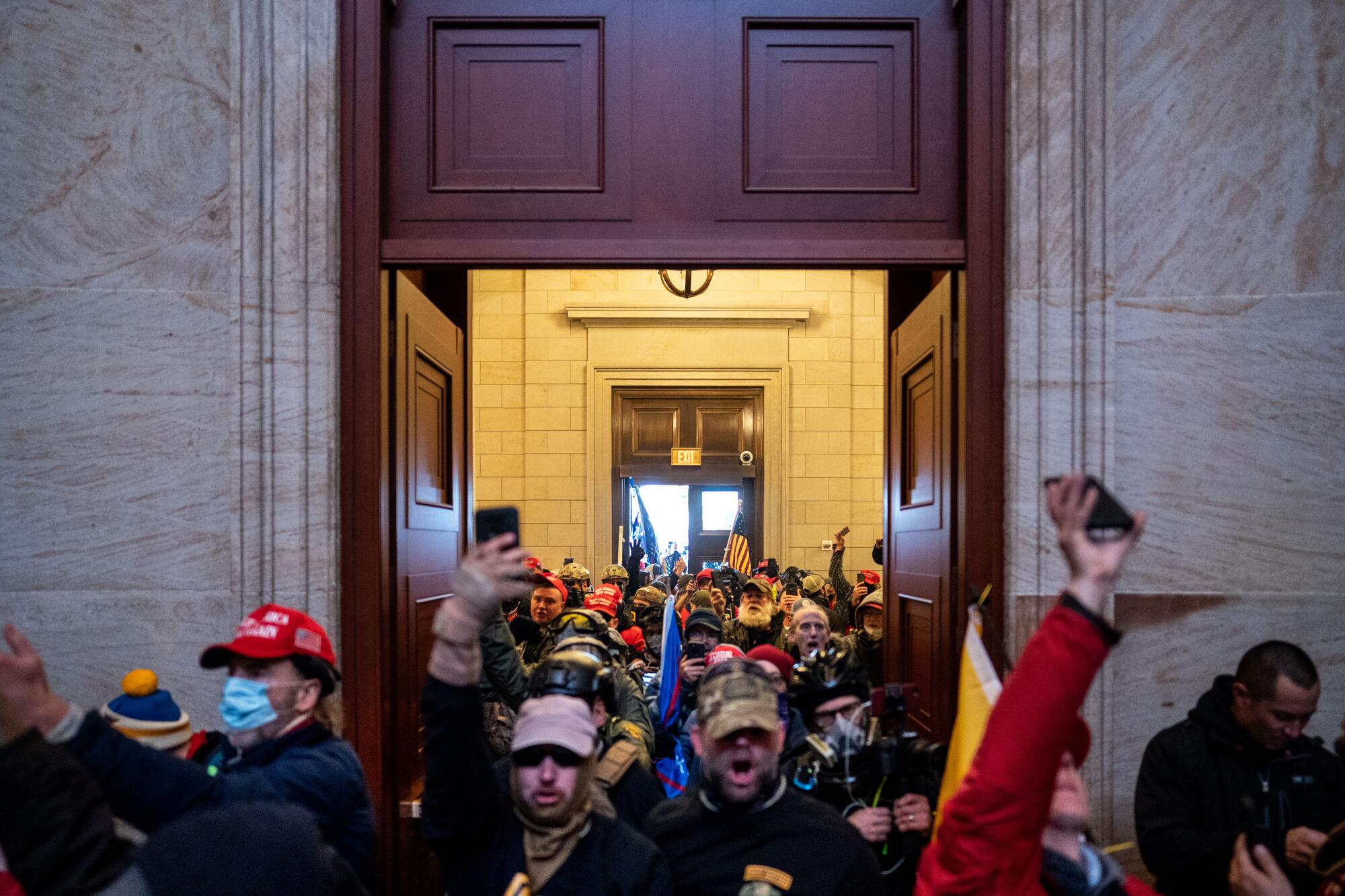
If COVID-19 hadn’t limited the number of people in the building that day, Torres said, there’s no telling what might have happened.
“I’m terrified what it would have been like if the gallery would have been full of people, innocent members of the public who come here to see ... magic happen on this floor or to just participate in the ceremony,” Torres said. “And every member of Congress [would have been] here. What would Capitol Police have been able to do?”
The Senate evacuates
The Secret Service rushed Pence out of the Senate and down a private set of stairs at 2:25 p.m.
Five minutes later, officers moved the furniture barricading the stairs, and senators and staff evacuated, winding down several flights to reach the subway between the Capitol and Senate office buildings. Officers headed in the opposite direction and into the Capitol building.
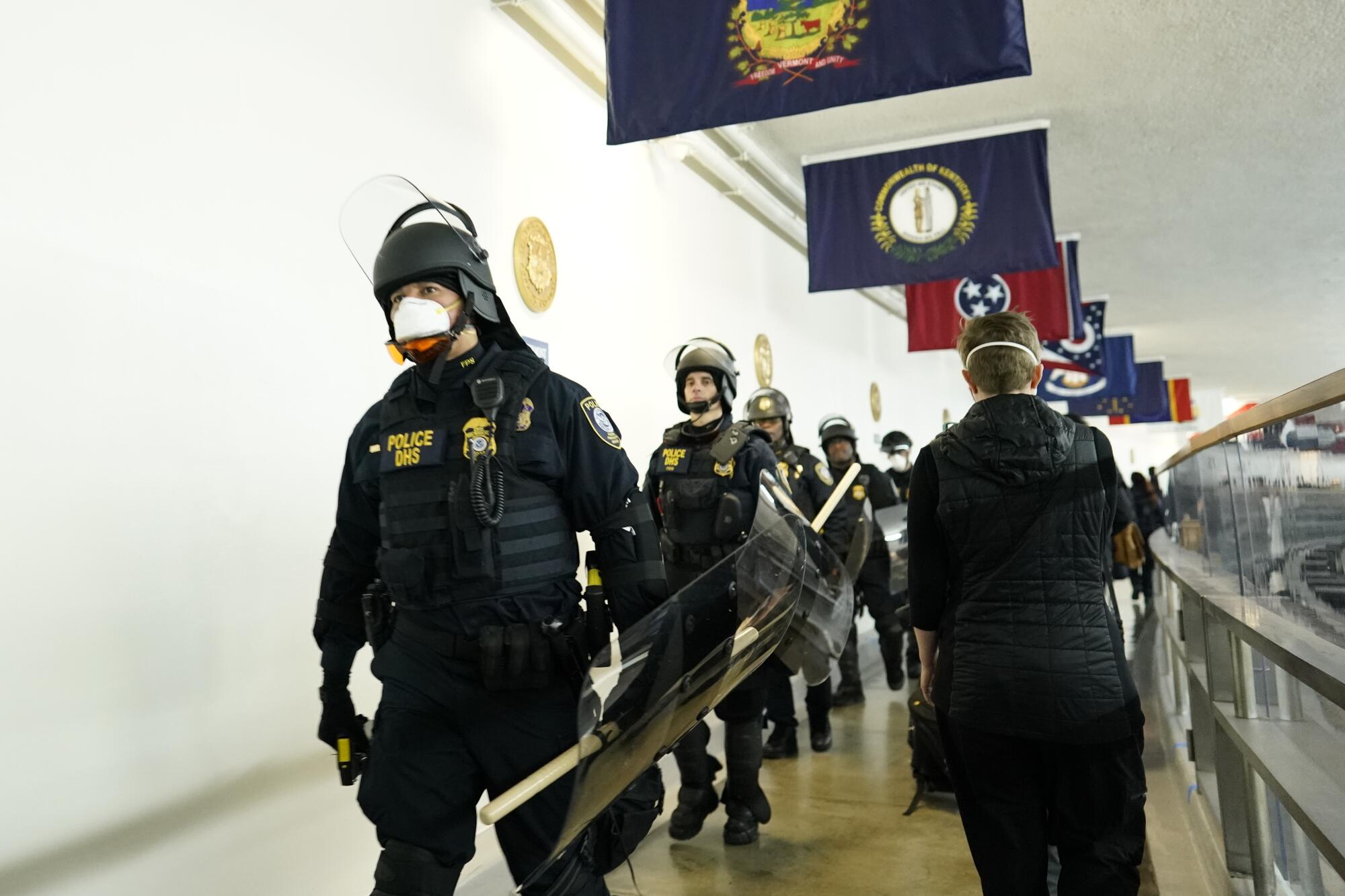
Women took off their heels to run down the lengthy tunnel to the Senate office buildings. Staff members carried large boxes full of electoral votes, preventing rioters from gaining control of the official records sent by the states declaring which candidate had received the most votes.
Boozman noticed Sen. Dianne Feinstein (D-Calif.), who had been deteriorating physically and mentally, fall toward the back of the pack of senators. She was on the phone and looked confused, he said, ignoring a young staff member who urged her to hurry up.
“I could talk to her in a different way than he could,” Boozman said. “So I said, ‘Senator, you need to put your phone away. This is very serious. We need to go,’ essentially. And so she put her phone away, and I kind of grabbed her and started walking.”
Boozman placed his arm across Feinstein’s back and clasped his hand around her upper arm as he led her away.
As they walked down Senate tunnels toward a safe room, Feinstein recounted finding the bodies of San Francisco Mayor George Moscone and Supervisor Harvey Milk after they were assassinated in 1978. Boozman had heard the story many times during their time together in Washington.
“She was aware of what was going on in the sense that that immediately came to her mind,” he said.
Two floors above them, at 2:44 p.m., the first rioter reached the door Pence used to escape from the Senate. Finding the door locked, the rioter dropped to his knees and began to pray.
More rioters arrived and rifled through staff desks in search of keys to get in.
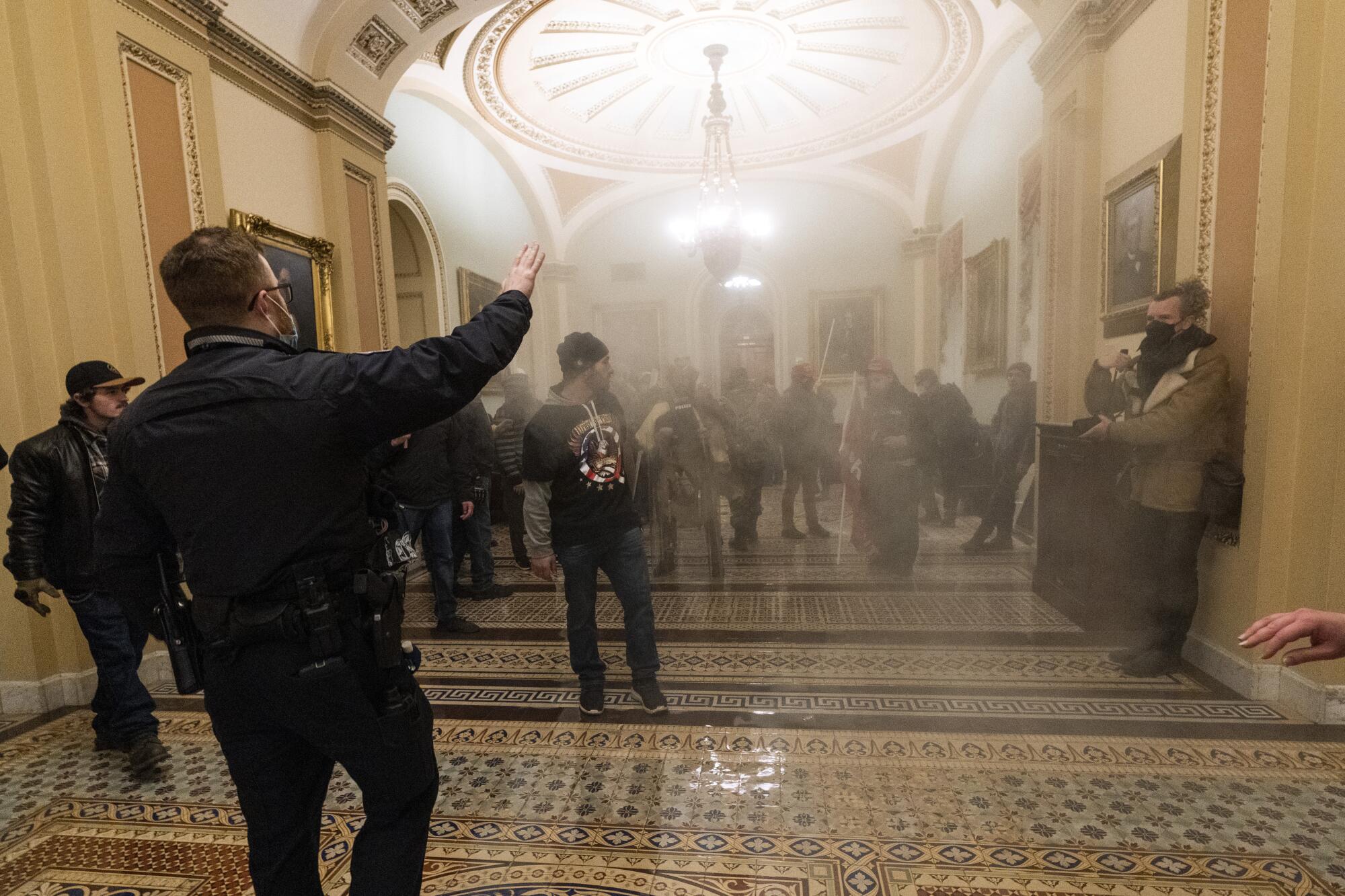
Soon rioters entered the Senate gallery. They jumped down onto the floor, looked through senators’ desks and opened the doors to let the waiting crowd inside.
Leaving the House gallery
Meanwhile, officers were doing everything they could to slow the crowd’s progress from the Rotunda and buy time for representatives to evacuate the House floor, surveillance footage shows.
In a burst of strength, the crowd shoved police officers backward until they reached the main House chamber doors at 2:36 p.m.
The glass on the main doors began to crack and shattered. I peeked over a chair into the chamber as then-Rep. Markwayne Mullin (R-Okla.) attempted to reason with the rioters who were trying to push their way in.
Inside the chamber, officers aimed their service weapons through the shattered glass.
“Oh, my God, they are going to fire on them,” Torres said in a video she recorded at the time.
An officer told representatives to get as low as possible. There was a frenetic pounding on the second-floor doors to the chamber and to the gallery doors on the third floor.
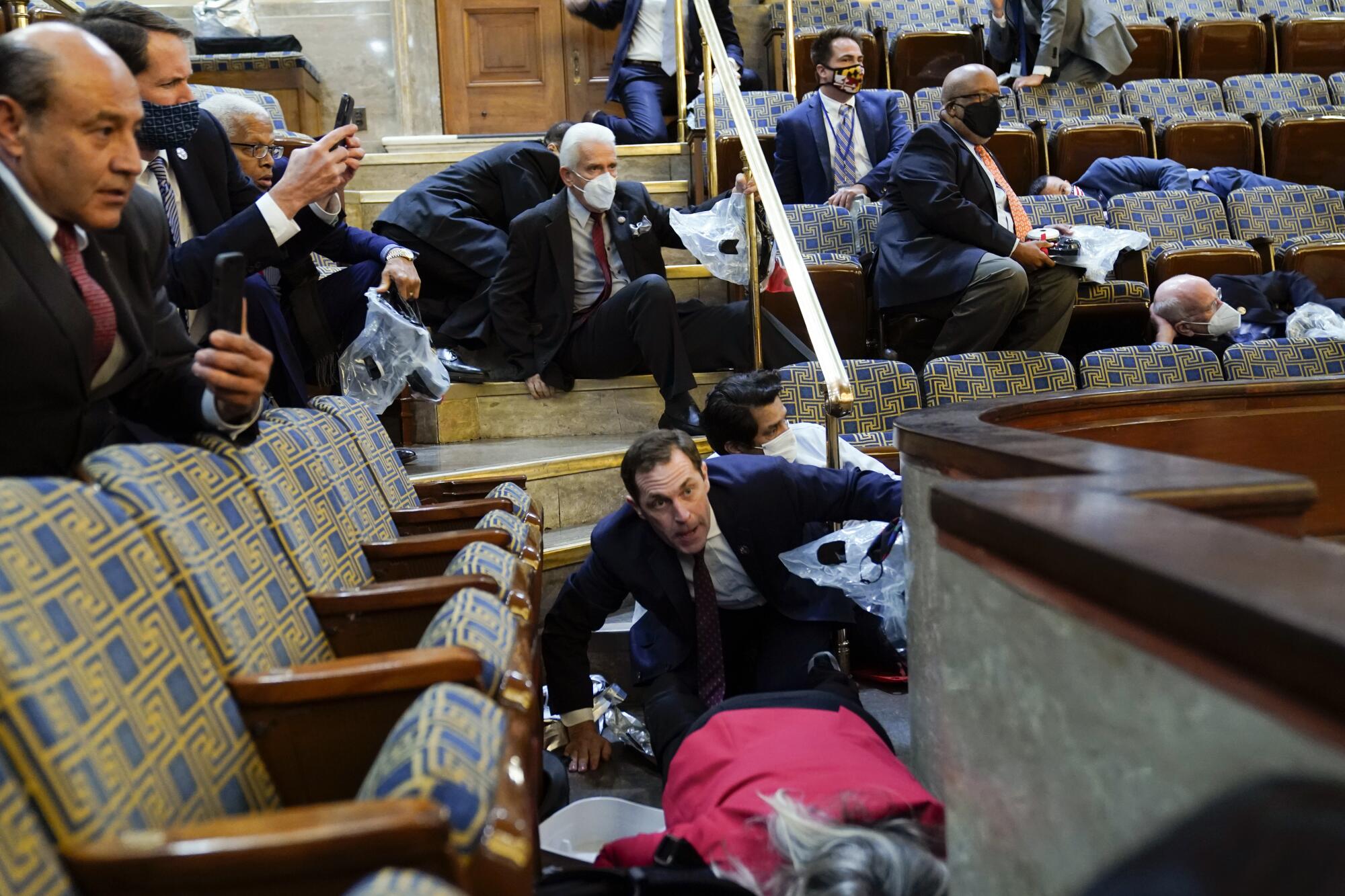
The second-floor crowd expanded, filling the east hallway. The officers guarding the House chamber and the east exterior entrance doors had moved into the chamber. Rioters opened the exterior doors to the throngs outside.
The crowd reached the entrance to the Speaker’s Lobby behind the House chamber. The rioters pounded on the glass doors, which had been barricaded with antique furniture, and broke the glass with their fists, flagpoles and helmets. Just yards away, more than a dozen members of Congress evacuated through the lobby.
One of the rioters, San Diego Air Force veteran Ashli Babbitt, began crawling through a hole in the glass. She was struck by a single, fatal bullet to her left shoulder, fired by a Capitol Police officer at 2:44 p.m.
A minute later, officers fired tear gas to break up the crowd outside the main House doors. After receiving little response, officers fired more canisters. A cloud of gas billowed to fill the hall. Finally, the crowd dissipated.
“You could see the smoke coming up” into the House chamber, Torres said. “I couldn’t believe it, any of it.”
The gunshot and the tear gas immediately quieted the crowd. Representatives’ prayers and the whine of the air-filtration hood motors echoed in the chamber. That whine would be a constant throughout the day, and still haunts my nightmares.
I crawled over to Torres. She took a photo of me to share online so my bosses would know I was safe. I tried to shake the thought that it might be the last photo of me alive.
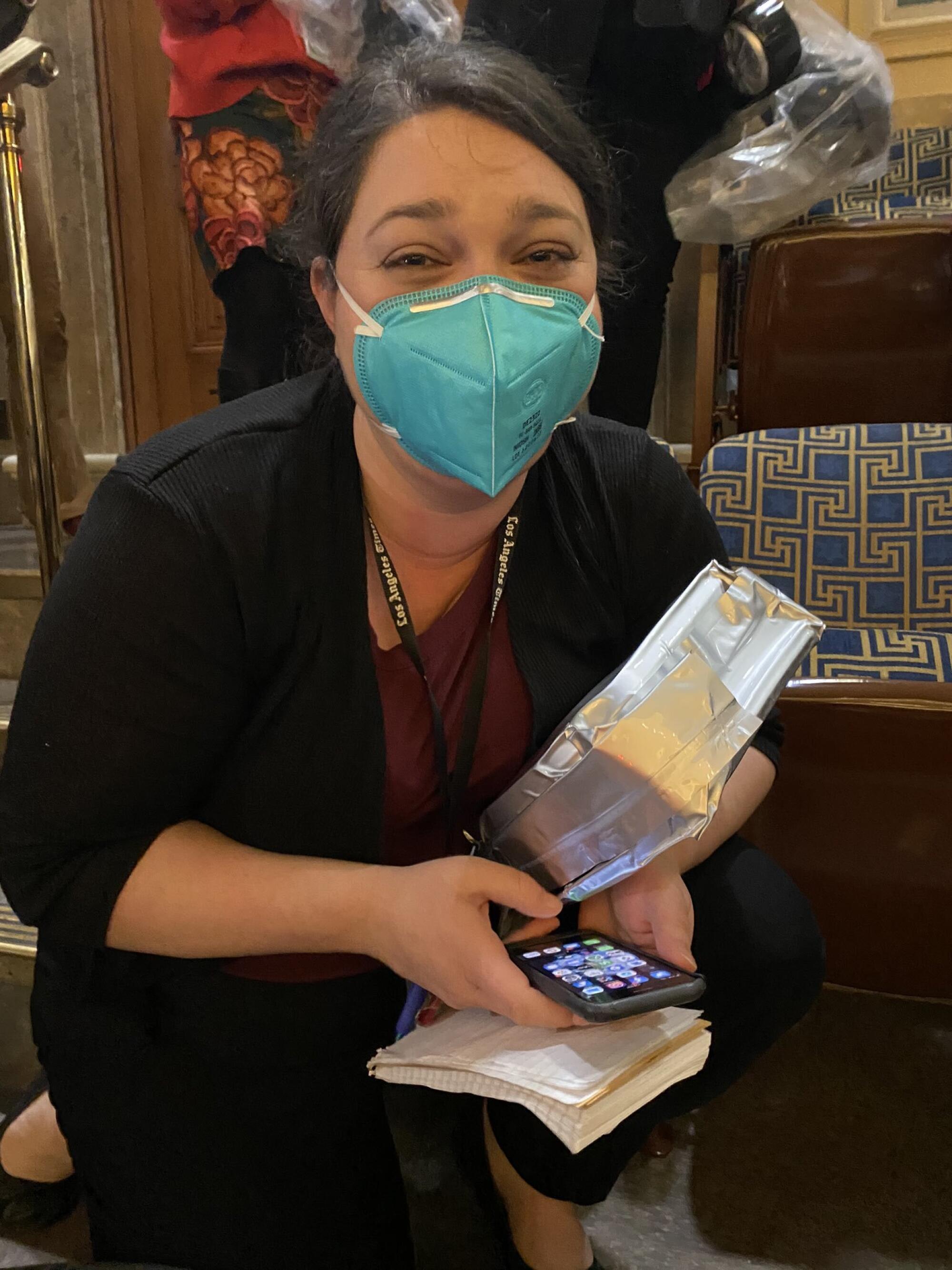
“Can I do the hardest part of my job and ask you what you are thinking right now?” I asked her.
“It’s horrible that this is America, this is the United States of America, and this is what we have to go through because Trump has called homegrown terrorists to come to the Capitol and invalidate people’s votes,” she replied.
Feet from us, in the hallway outside the locked doors, the crowd on the third floor had grown. Security footage shows the rioters pounding on doors, rattling doorknobs and filing in and out of an unlocked office.
Officers started retaking control of the hall by 2:45 p.m.
Lawmakers and police officers argued inside about whether to run for it. One of the doors briefly opened, and a few people made it out before the rioters noticed. Officers locked the door from inside seconds before the rioters reached it.
- Share via
Rep. Norma Torres shares video of members of Congress and reporters waiting to be evacuated from the gallery while rioters try to break into the House chamber on Jan. 6, 2021.
“We were saying, ‘Where are we going to go?’ We were scared what was going to be on the other side of the door,” Torres said. “The pounding on the doors was horrible.”
Video shot by Torres shows an officer telling people in the gallery to prepare to move quickly and calmly once the door opened again.
“Wait for the direction. They are going to make sure it is clear first,” the unidentified officer said, her voice rising to be heard.
Security footage at that time shows a phalanx of officers carrying assault-style weapons marching up a flight of stairs and ordering rioters to the ground. One officer pointed a grenade or tear-gas launcher at the rioters’ heads.
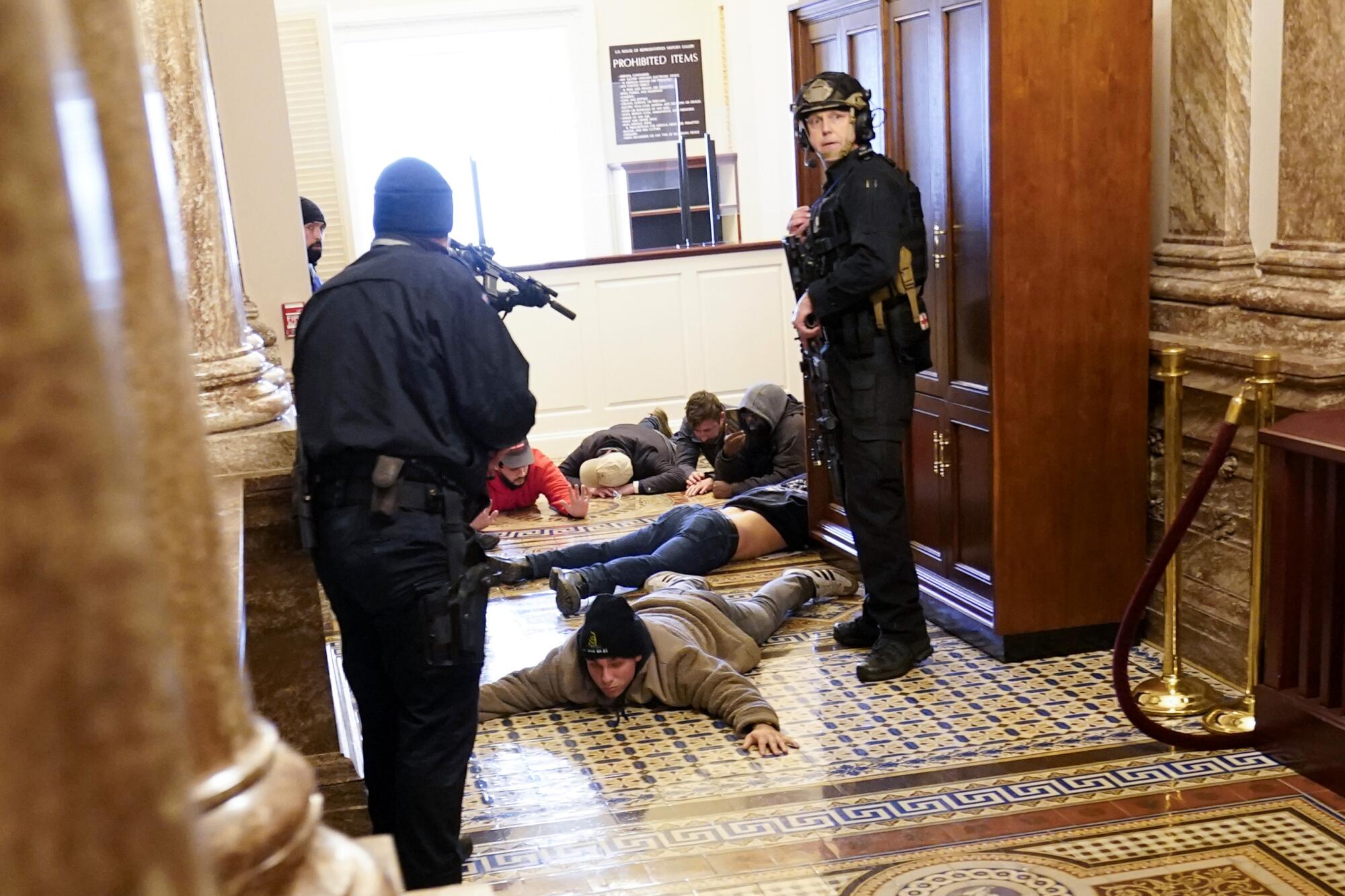
The evacuation of the House gallery began at 2:51 p.m. I zeroed in on the rioters peering up at us from the floor and was shaken by how close they were. A few feet from me in the crowd, Torres first saw blood on an officer, she said.
Torres and other members screamed when white officers in plainclothes ran toward them, thinking they were rioters.
“I never thought I would be afraid of a person because of the color of their skin or how they look. These experiences were all new to me,” Torres said.
As my foot hit the first step of the marble staircase that was our escape route, I realized that I hadn’t told my husband I was safe.
“I’m ok. Being evacuated,” I texted him at 2:57 p.m., too overwhelmed to give details.
“Big exhale,” he replied. “Ok. Keep me updated. Love you.”
As she started down the stairs, Torres took a phone call from one of her sons.
“I regret so much saying to him that I was running for my life. He’s a police officer, and he was watching on TV, and it looked horrible,” she said.
Torres asked staff to update her family the rest of the day. She knew she would lose composure if she spoke to her husband or her other children.
We passed the tear-gas-filled hall on the second floor and made our way down a warren of hallways, a winding staircase and a long tunnel. I interviewed lawmakers on the way.
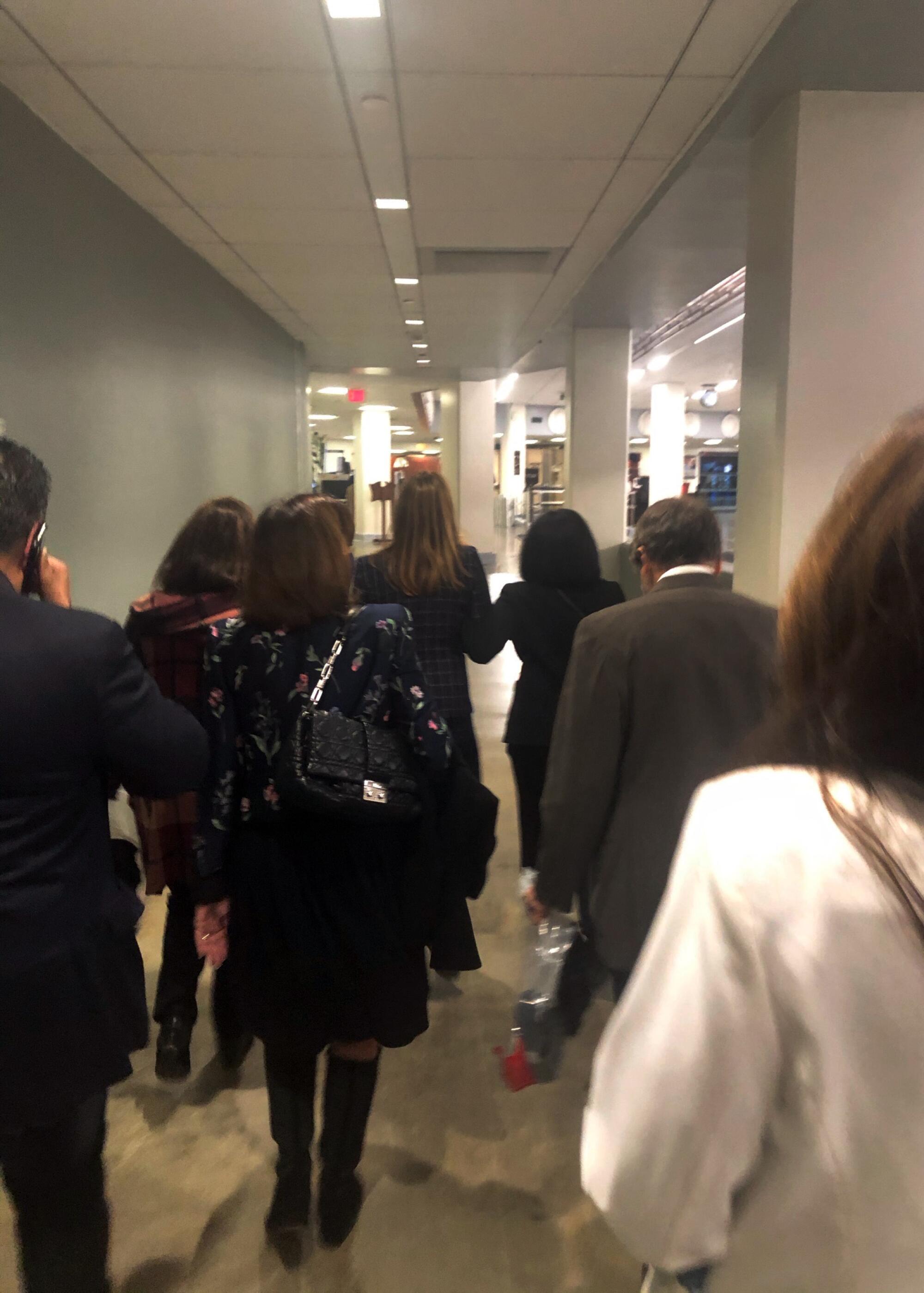
The representatives who had evacuated from the House floor carried gas masks and weapons made from broken furniture or anything else they found along the way. They reached the safe room by 2:50 p.m., security footage shows.
Somehow, I wasn’t blocked like other reporters and made it into the safe room, where I continued my interviews.
As members typed on their phones and received updates from security officials, staff handed out snacks and bottles of water.
A member pleaded with colleagues not to give interviews, worried we might accidentally betray our location.
“Lady, I’m in here too,” I thought.
Fleeing the Senate
Meanwhile, in the Senate safe room, senators, reporters and staff watched coverage of the riot happening around them.
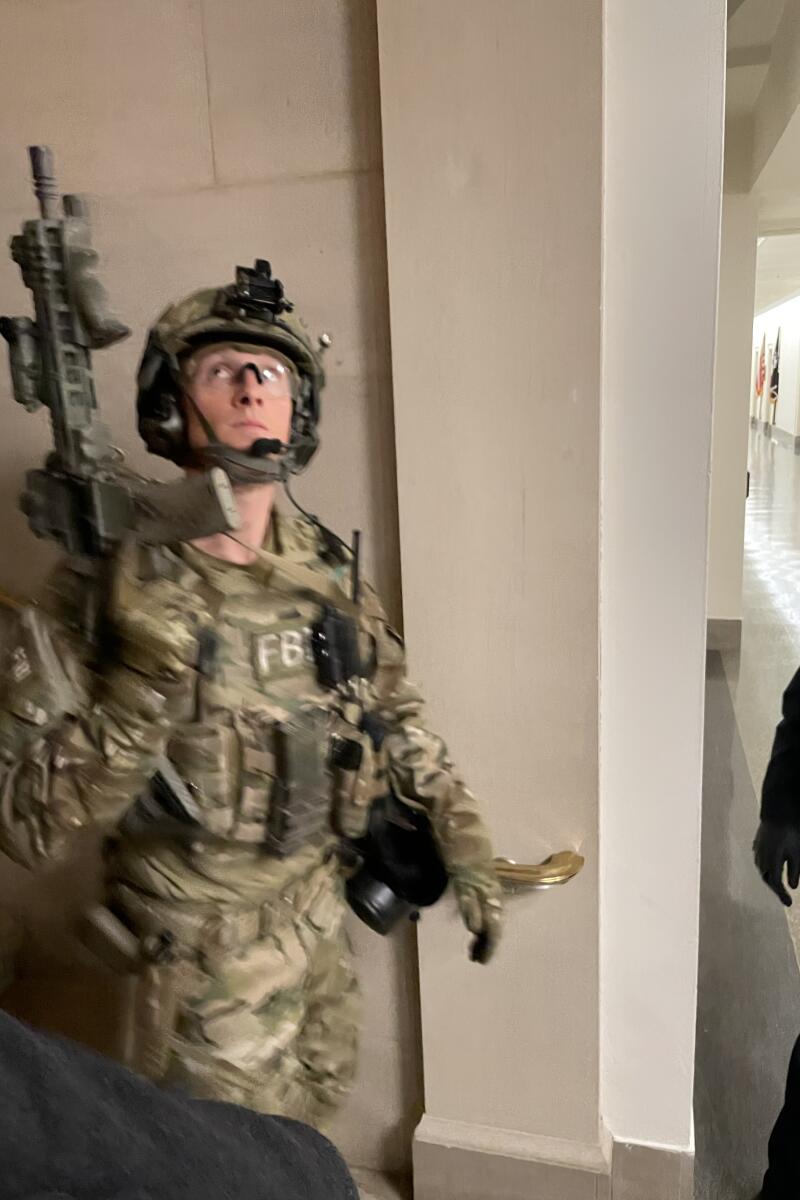
Laslo, a congressional reporter and new media professor at John Hopkins University, documented the events. (Matt Laslo)
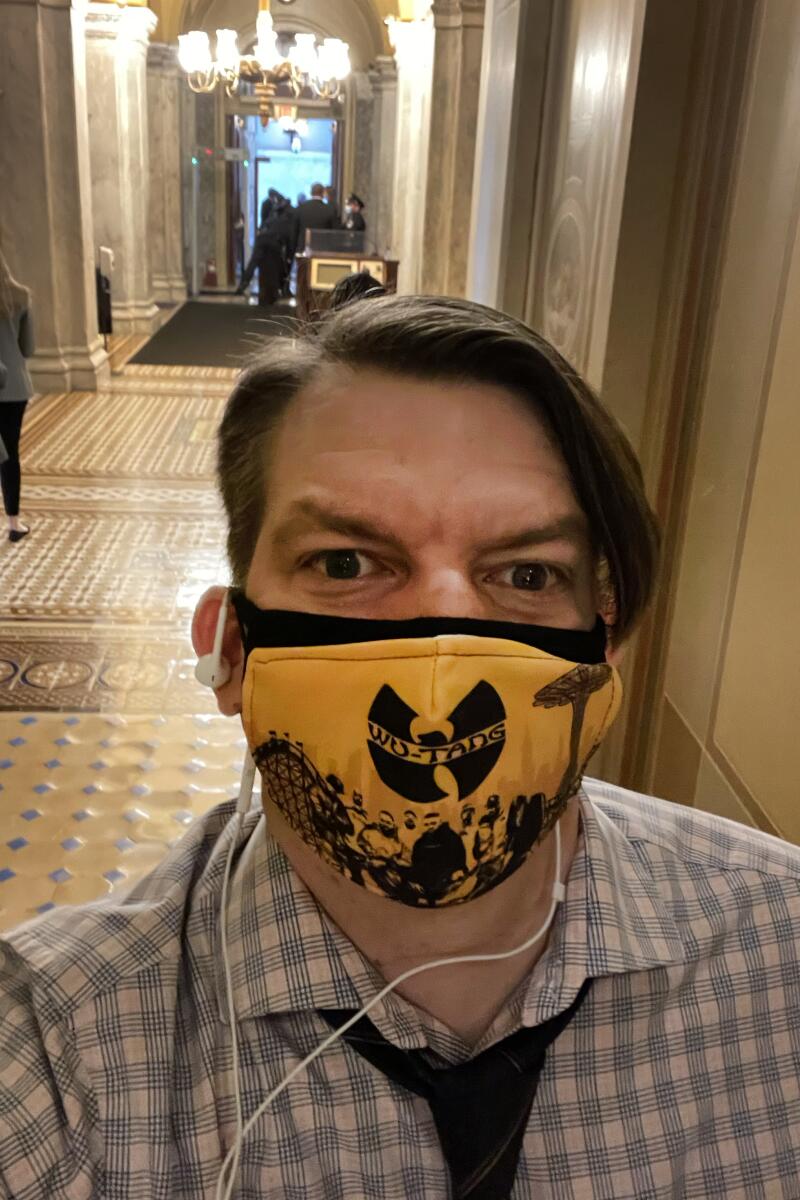
Laslo at the Capitol. (Matt Laslo)
“You could actually see on television what was happening to the areas that you just left,” Boozman said. “I think that’s really when we realized the full extent of what was going on.”
Surveillance footage shows officers clearing Senate staff and reporters from third-floor offices at about 3:20 p.m.
While reporters waited to be evacuated, they pulled down signs on desks identifying the news organizations that used them, turned off lights and hid so they couldn’t be seen through a window in the door.
Laslo hung a blazer over the sign for the radio-TV press gallery. He prepared for the possibility that reporters would have to get out of the building on their own by hiding his press pass and ripping his shirt to expose his tattoos. He armed himself with a wrench and a wooden doorstop that he fashioned into a shiv.
“I was walking around all the booths looking for anything that could be a makeshift weapon,” he said.
Laslo took a shot of moonshine from the bottle in his desk and left with another reporter at 3:54 p.m. He spotted a Gadsden flag left behind by rioters and ripped it from its pole, thinking he might drape it over himself to blend into the crowd.
At 4:01 p.m., Laslo passed the Senate-wing windows from which he had filmed rioters breaking in hours before, finding they were blocked with broken furniture. Officers braced the barricade with their bodies as the crowd outside screamed at them through broken panes.
Moments later, Laslo caught up with a group of about 25 staffers who had hidden under a conference-room table for hours as the mob ransacked Pelosi’s suite. Security footage shows officers amassing on the upper West Terrace around the same time to repel rioters who remained on the presidential inauguration stand or the West Lawn.
Two windows and two doors used by Jan. 6 rioters were among only a few that weren’t reinforced during a Capitol security upgrade that started in 2017.
After police separated Laslo from Pelosi’s team, he spent hours waiting in a cafeteria with dozens of other reporters and staffers, watching teams of armed federal agency officers rush down the halls toward the Capitol or up the stairs of the office building to look for rioters hiding inside.
At one point, Laslo climbed out an upper-story window, planning to jump to a nearby tree in order to get off Capitol grounds.
“I was getting claustrophobic,” he said. “I needed to be gone.”
An officer at the street level waited for Laslo to finish a cigarette, then ordered him back inside.
In the House safe room,then-Rep. Jackie Speier (D-Hillsborough) repeatedly put her hand on my shoulder as she walked by. I realized I was visibly trembling. It would be hours before I stopped.
Congress finishes its work
Around 5:30 p.m., the House’s top security official announced that the Capitol was secure. He urged members to stay in the safe room until the grounds were cleared. At 5:45 p.m., police regained control of the West Terrace and West Lawn.
At about 6:30 p.m., Pelosi entered the room. She condemned the “mobs desecrating the halls of the Capitol of the United States” and declared that the House and Senate would return immediately to finish their work.
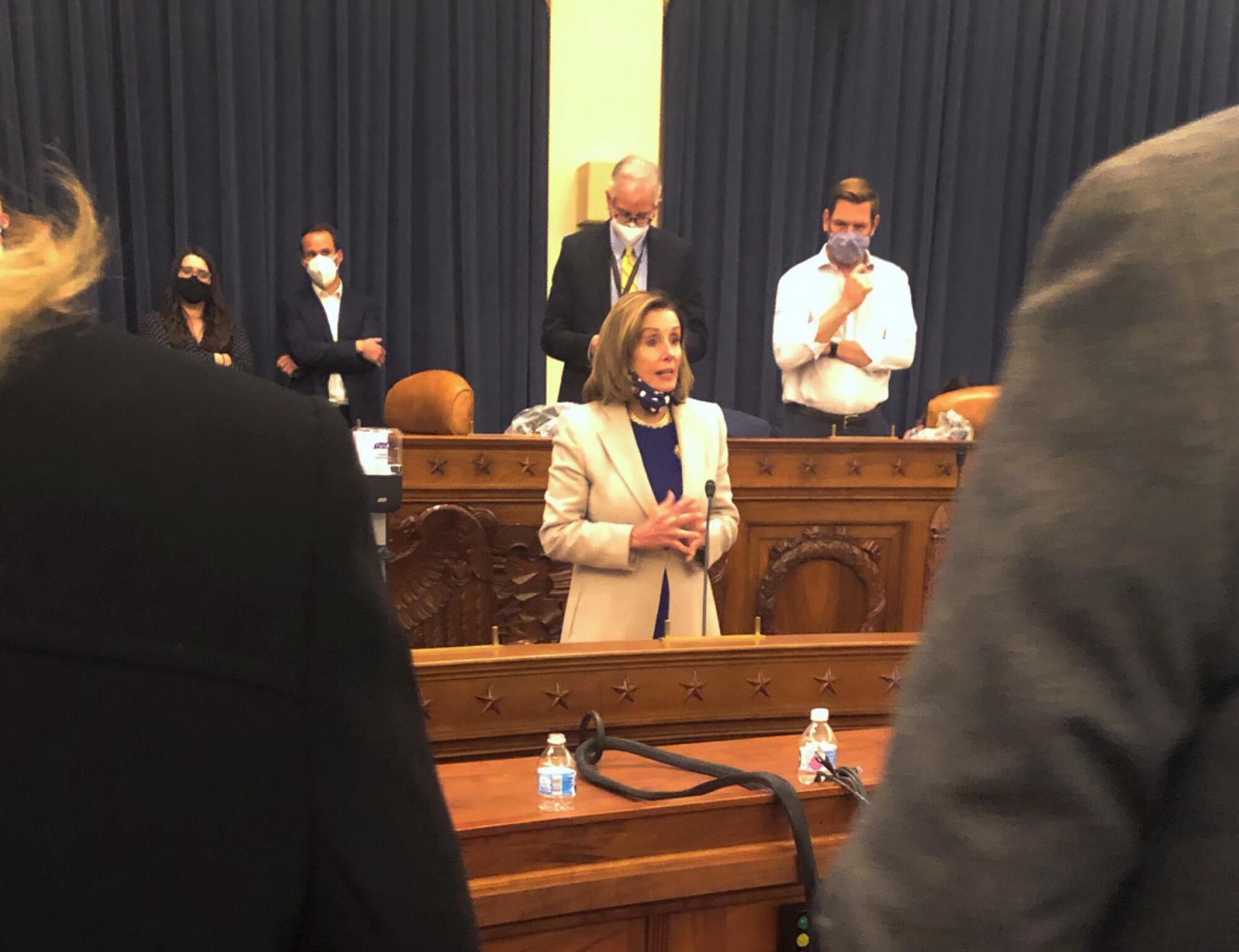
Laslo and others in the cafeteria were allowed to leave at 7:14 p.m. He walked to the edge of the Capitol campus and hailed a taxi. It took him hours to make it home.
Representatives were allowed to leave the safe room at roughly the same time.
On my way back to the House gallery to finish covering the electoral count certification, I slipped in the tear gas and fire extinguisher residue that coated the floors. Custodial staff who had remained hidden for hours as the insurrection raged worked quickly to clean up glass shards, broken furniture, blood and even feces smeared on the walls so that Congress could resume its work.
At 8 p.m., the Capitol complex was officially declared secure.
“Today was a dark day in the history of the United States Capitol,” Pence said when he gaveled the Senate back into session six minutes later.
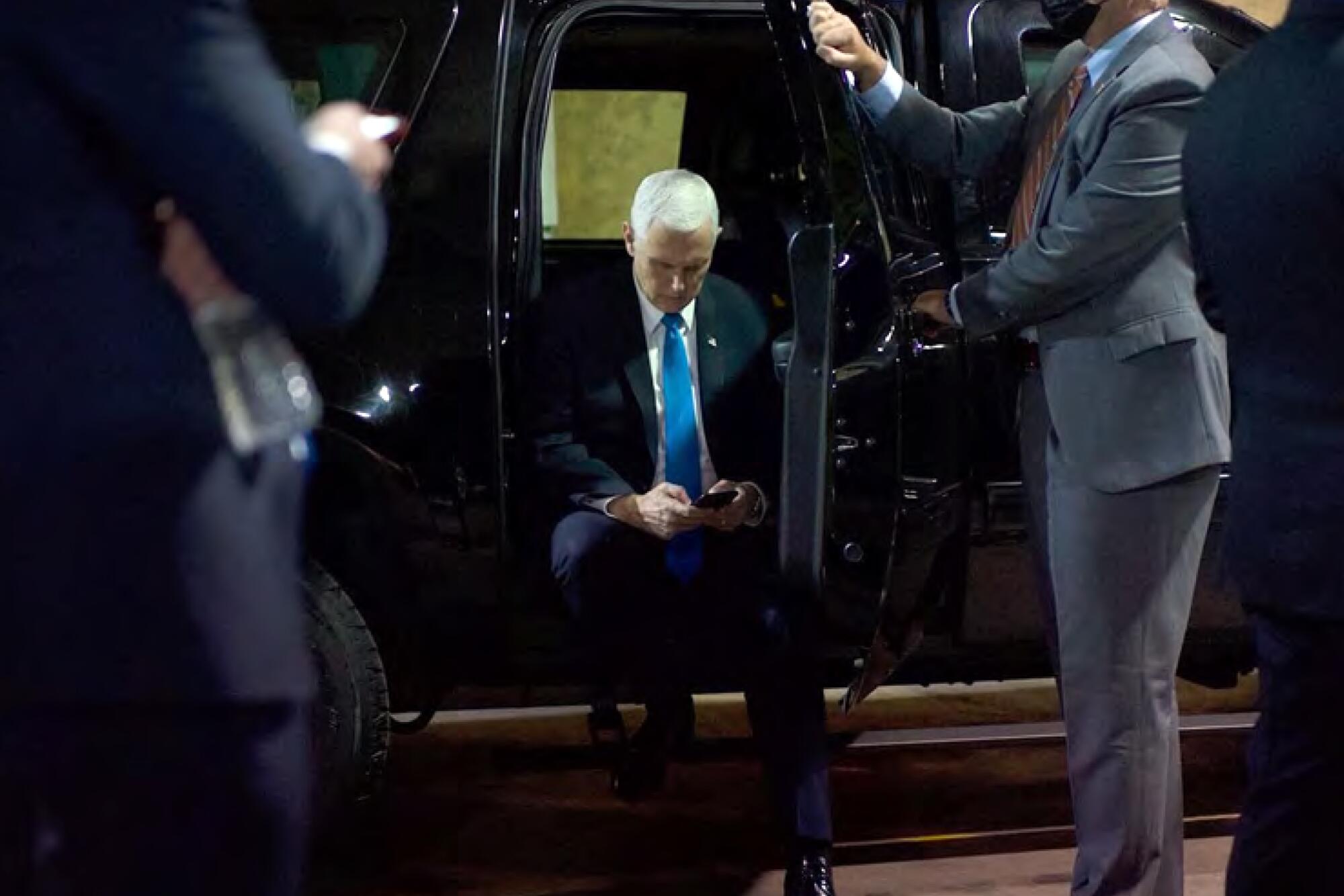
Boozman said he stayed until the very end.
“I think the consensus on both sides was, ‘We’re going to do our job,’” he said. “‘We’re not going to succumb to any delay based on that kind of activity.’”
Torres sat in the last row of seats on the House floor as deliberations resumed.
“That’s when my skin started burning,” she said. A few minutes later, an officer cautioned members that the tear gas hadn’t been cleaned off the chairs.
Debate continued for hours. Torres headed back to her office around midnight.
“I felt so scared and alone,” she said. “I grabbed a baseball bat from the [congressional] women’s softball team, and I cleared my offices with that to make sure nobody was in there, nobody had gotten in there. And once I did that, I sat down and cried, and I finally called my husband.”
At 3:44 a.m., Congress certified Joe Biden’s win.
More to Read
Get the L.A. Times Politics newsletter
Deeply reported insights into legislation, politics and policy from Sacramento, Washington and beyond. In your inbox three times per week.
You may occasionally receive promotional content from the Los Angeles Times.


